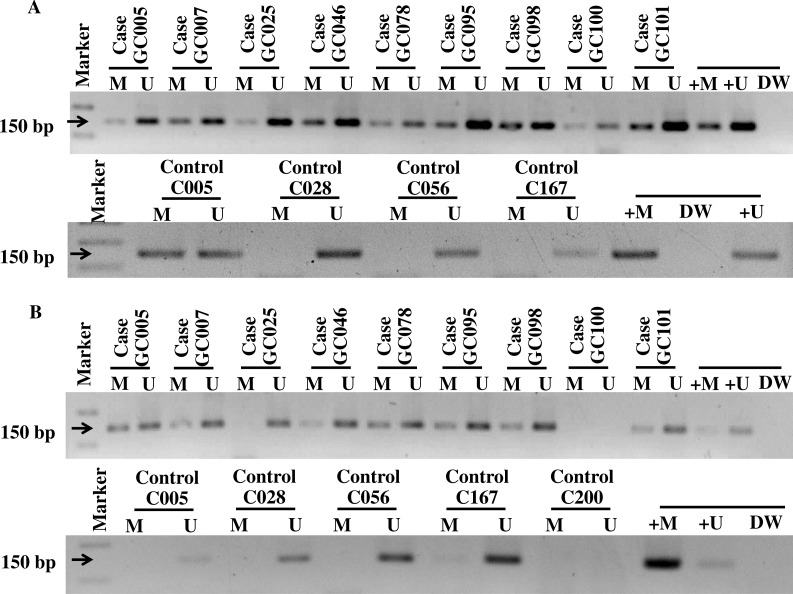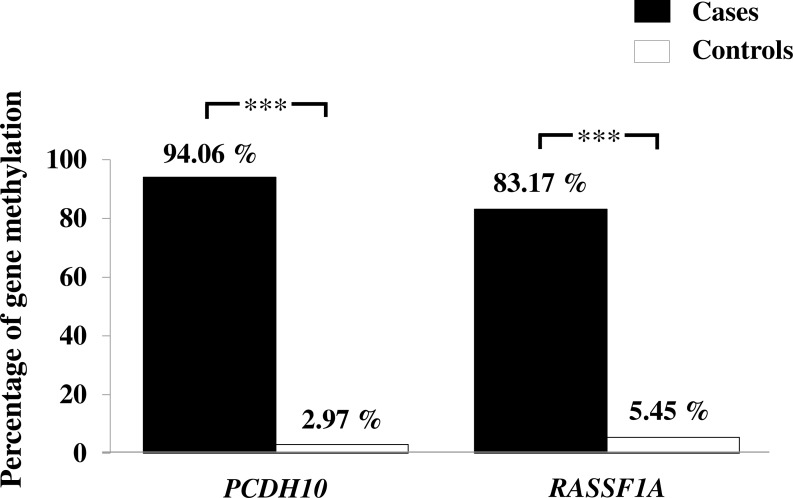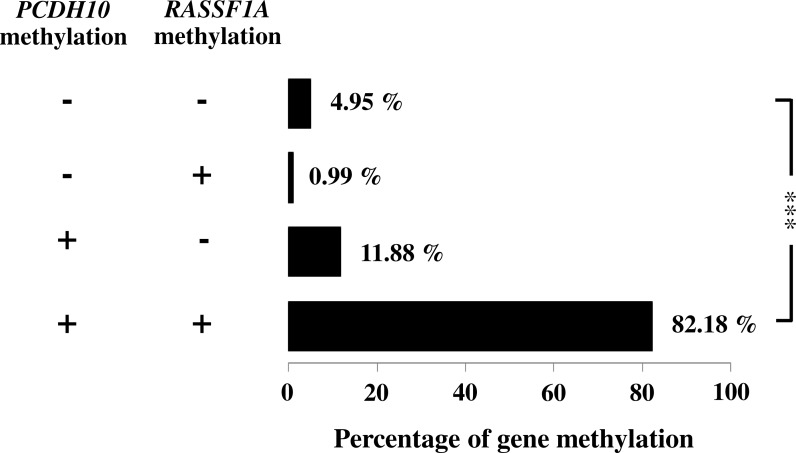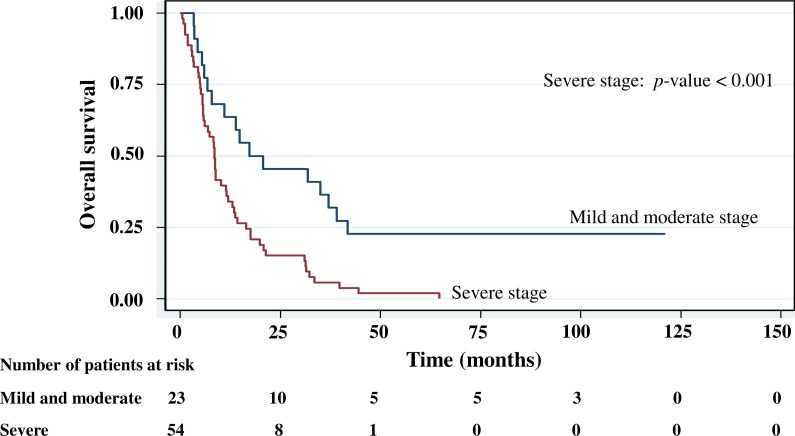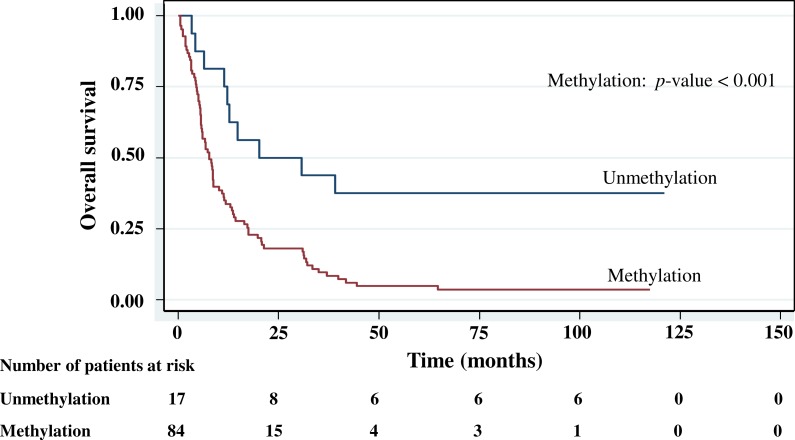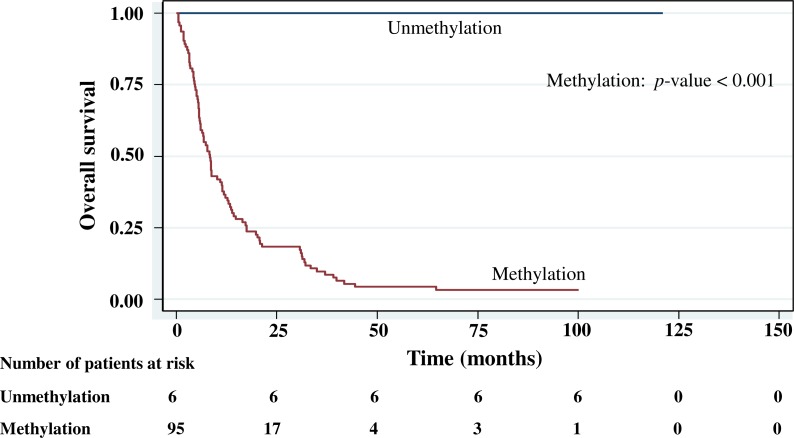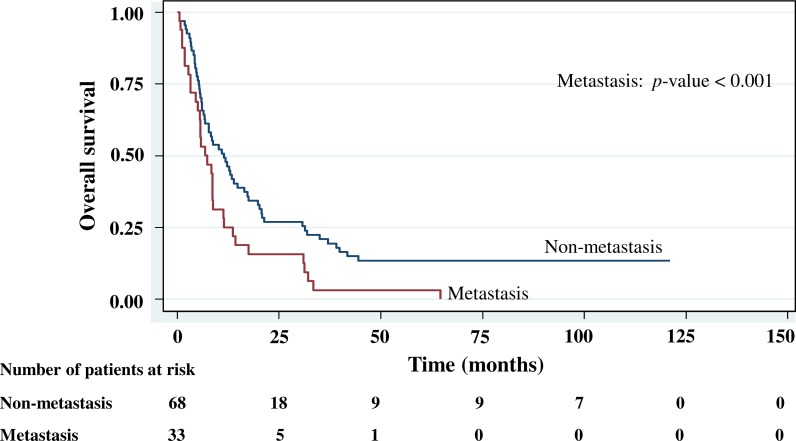Abstract
Background. Assessment of DNA methylation of specific genes is one approach to the diagnosis of cancer worldwide. Early stage detection is necessary to reduce the mortality rate of cancers, including those occurring in the stomach. For this purpose, tumor cells in circulating blood offer promising candidates for non-invasive diagnosis. Transcriptional inactivation of tumor suppressor genes, like PCDH10 and RASSF1A, by methylation is associated with progression of gastric cancer, and such methylation can therefore be utilized as a biomarker.
Methods. The present research was conducted to evaluate DNA methylation in these two genes using blood samples of gastric cancer cases. Clinicopathological data were also analyzed and cumulative survival rates generated for comparison.
Results. High frequencies of PCDH10 and RASSF1A methylations in the gastric cancer group were noted (94.1% and 83.2%, respectively, as compared to 2.97% and 5.45% in 202 matched controls). Most patients (53.4%) were in severe stage of the disease, with a median survival time of 8.4 months after diagnosis. Likewise, the patients with metastases, or RASSF1A and PCDH10 methylations, had median survival times of 7.3, 7.8, and 8.4 months, respectively. A Kaplan–Meier analysis showed that cumulative survival was significantly lower in those cases positive for methylation of RASSF1A than in their negative counterparts. Similarly, whereas almost 100% of patients positive for PCDH10 methylation had died after five years, none of the negative cases died over this period. Notably, the methylations of RASSF1A and PCDH10 were found to be higher in the late-stage patients and were also significantly correlated with metastasis and histology.
Conclusions. PCDH10 and RASSF1A methylations in blood samples can serve as potential non-invasive diagnostic indicators in blood for gastric cancer. In addition to RASSF1A methylation, tumor stage proved to be a major prognostic factor in terms of survival rates.
Keywords: Gastric cancer, PCDH10, RASSF1A methylation, Survival, Clinicopathological factors
Introduction
Gastric cancer is in the top three causes of cancer mortality worldwide (Lin, Huang & Juan, 2012) and in 2012 was the fifth most common cancer with more than 70% occurring in developing countries and with especially high incidences in Eastern Asia. Rates in men are generally twice those in women (Ferro et al., 2014). Although advances in treatment can help prolong patient life, mortality rates are still high in many countries because established cancer screening programs are limited and presentation is very often at the late stage (Hamashima et al., 2015). While there exist several novel screening techniques available for early detection, such as testing for pepsinogens and H. pylori factors in the circulation (Miki et al., 2003; Miki, 2011; Liu et al., 2014; Pasechnikov et al., 2014), these strategies may not be appropriate in a relatively low risk country like Thailand.
In general, blood samples can be particularly useful in cancer screening by, for example, a proteomics approach (Li et al., 2012a; Li et al., 2012b). Both circulating tumor cells and cell free DNA may have prognostic value (Ignatiadis & Dawson, 2014; Madic et al., 2015). Although challenges exist, effective methodology has been established (Coumans et al., 2012; Saucedo-Zeni et al., 2012), and the search is on for serum cancer markers with good sensitivity and specificity (Hung, Chiu & Lo, 2009; Kohler et al., 2011; Sayres & Cho, 2011). There are several reports that DNA methylation can be applied with tumor tissues harvested after surgical operation or biopsy for prediction of prognosis. Moreover, its presence in serum offers clear advantages for non-invasive detection. DNA methylation plays an important role in silencing tumor suppressor genes during cancer development by adding a methyl group from S-adenosyl-L-methionine to the cytosine or adenine ring in CpG islands of genes (Levenson, 2010; Warton & Samimi, 2015). DNA methylation can thus suppress the transcription of many tumor suppressor genes protecting against cancer initiation and progression (Jones & Baylin, 2007), and thus offer tools for screening.
The PCDH10 gene is classified as a tumor suppressor gene in the protocadherin family, a cadherin subfamily. PCDH10 function specifies cell–cell adhesion via Ca2+ in tissue morphogenetic processes (Almeida et al., 2010; Otani et al., 2013) and apoptosis by upregulation of Fas, Caspase 8, Jun, CDKN1A, and HTATIP2 (Yu et al., 2009). The methylation of PCDH10 is involved in metastasis and has been found in many carcinomas, including colorectal, nasopharyngeal, esophageal, hepatocellular, breast, cervical, and lung cancers, and also in gastric cancer (Li et al., 2012a; Li et al., 2012b; Deng et al., 2014). The RAS association domain family 1A gene (RASSF1A) or RASSF1A blocks cell-cycle progression and inhibits cyclin D1 accumulation. Furthermore, RAS regulates a pro-apoptotic pathway by binding to the RAS effectors, NORE1 and RASSF1A, and activates apoptotic protein kinases such as MST1 (Dammann et al., 2003). RASSF1A is also classified as a tumor suppressor gene, and its methylation may lead to increased cell proliferation, invasion, and metastasis (Hesson, Cooper & Latif, 2007).
There have been reports about alteration of either PCDH10 or RASSF1A in gastric cancer tissues or cell lines (Byun et al., 2001; Dammann et al., 2003; Shi et al., 2014), but none of the studies investigated both genes together. In addition, to our knowledge, only a few specifically addressed the methylation of RASSF1A in DNA extracted from peripheral blood (Balgkouranidou et al., 2015; Wang et al., 2008). Thus, the aim of this research was to assess the methylation status of PCDH10 and RASSF1A of DNA in blood samples of gastric cancer patients. This study also included an investigation of clinicopathological characteristics affecting the survival rate of this patient group in northeastern Thailand.
Materials and Methods
Population and specimens
Specimens were obtained from gastric cancer patients who visited two of the largest hospitals in the northeast of Thailand (Srinagarind Hospital at Khon Kaen University—a medical school hospital, and Khon Kaen Hospital—a regional public hospital) and had resided in the area for at least five years. The patients were initially diagnosed by the specialist and confirmed by histopathology and diagnosed according to the International Classification of Diseases for Oncology in the period between October 2002 and 2006. All patients were followed-up until death or the end of the study period (31 October, 2012). This study was approved by the Khon Kaen University Ethics Committee for Human Research (HE 581260, dated 20 July, 2015). General demographic characteristics, such as age and sex, were assessed along with clinicopathological parameters of gastric cancer.
EDTA blood samples were collected by venipuncture from 101 patients diagnosed with gastric cancer according to the International Classification of Diseases for Oncology (ICD-O 3rd) and confirmed by histopathology. Each case was matched with two controls (a total of 202) by gender, age (±3 years), hospital, and provincial residence. The participants with gastrointestinal disease were excluded. All participants provided written informed consent prior to the beginning of the study. The participants who refused, or unable to answer our interview were excluded from the study.
Plasma was separated by centrifugation at 2000 × g for 15 min at room temperature. All samples were stored at −20 °C until DNA extraction. All patients were followed-up until death or the end of the study period (31 October, 2012). Data of interest were retrieved from medical records including age on the day of diagnosis, gender, site of cancer, histopathology, histological grading, stage of disease, and tumor metastasis. The classical endpoint was survival time. The clinicopathological status of each patient was checked from medical records and by linkage with the death registry of the Thai national statistics database.
DNA extraction
The cell-free DNA was extracted from plasma using the standard protocol of the Genomic DNA Mini Kit (Geneaid Biotech). Briefly, 200 µl of plasma was mixed with 200 µl of working solution and incubated at 60 °C for 10 min. The DNA isolation was then processed as described in the manufacturer’s protocol. DNA samples were stored at −80 °C until used.
Gene methylation by methylation-specific polymerase chain reaction
Methylation-specific PCR (MSP) was used to evaluate methylation status based on bisulfite reactivity. Firstly, DNA was denatured to create single-stranded DNA and then modified with sodium bisulfite followed by a PCR using two pairs of primers: (1) specific for methylated DNA and (2) specific for unmethylated DNA. Bisulfite modification was used to perform the conversion of unmethylated cytosine to uracil except for the 5-methylcytosines. Bisulfite conversion was carried out up to 2 µg of extracted DNA in accordance with the instructions of EpiTect Bisulfite Kit (Qiagen, Hilden, Germany). PCR reactions were carried out in a total volume of 25 µl per 1 reaction containing 2.5 µl of 10X PCR buffer, 0.5 µl of 50 mM Mgcl2, 1 µl of 10 mM dNTP, 0.5 µl of forward primer (10 µM), 0.5 µl of reverse primer (10 µM), and 1 µl of template modified DNA.
To investigate the methylation of PCDH10 promoters, the orders of bases in unmethylation and methylation of PCDH10 forward and reverse primers were as follows: 5′-GTTGTT AAATAGATATGTTATGT-3′ and 5′-CTAAAAACTAAAAACTTTCCACA-3′; 5′-TCGTTA AATAGATACGTTACGC-3′, and 5′-TAAAAACTAAAAACT TTCCGCG-3′, respectively. MSP conditions were setup as follows: a hot start at 95 °C for 15 min followed by 55 cycles of 95 °C for 30 s, 59 °C for 30 s, 72 °C for 30 s, and finally 72 °C for 8 min (final extension).
The sequences of specific primers in unmethylation of RASSF1A promoters (forward and reverse primers) were as follows: 5′ GGTTTTGTGAGAGTGTGTTTAG-3′ and 5′-CACTAACAAACACAAACCAAAC-3′; and 5′-GGGTTTTGCGAGAGCGCG-3′, and 5′-GCTAACAAAGCGGAACCG-3′ for RASSF1A methylation, respectively. The condition of MSP was setup as follows: a hot start at 95 °C for 15 min followed by 55 cycles of 95 °C, for 30 s, 59 °C for 30 s, 72 °C for 30 s, and finally 72 °C for 8 min (final extension). Positive methylated DNA was human peripheral blood leukocyte DNA which was treated with 75 units of M.SssI methylase, and positive unmethylated was non-treated DNA.
The amplified 150 bp products from the methylated and unmethylated PCDH10 and RASSF1Awere run on 2% agarose gel with 1,000 bp DNA ladder, and stained with ethidium bromide and visualized in UV light.
Statistical analysis
Statistical comparisons of prevalence data were performed using the Fisher’s exact test. Where indicated, p < 0.001 is denoted ***; 0.001 < p < 0.01 is denoted **, and 0.01 < p < 0.05 is denoted *. Survival times were calculated for each patient and started from the date of diagnosis until the date of the death or the end of following-up period (31 October, 2012). Percentages were used to describe categorical data. Means with standard deviations or medians with ranges were used to describe continuous data characteristics. The survival probabilities were determined by the Kaplan–Meier method. Comparisons were made with the log-rank test. Univariate and multivariate Cox proportional hazard regression models were used to estimate the association between explanatory variables and survival experience, and the results presented in the form of crude and adjusted hazard ratios (HR) and their 95% confidence intervals (CI). All analyses were conducted using Stata version 10.0 (http://www.stata.com/). P-values are two-tailed and reported without any formal correction for multiple comparisons.
Results
General characteristics of the gastric cancer patients (101), such as gender and age, and frequencies of clinicopathological variables are summarized in Table 1. Findings for the methylation status are shown in Fig. 1. With both PCDH10 and RASSF1A, methylation was very rare in controls (2.97% and 5.45%, respectively), but exceedingly common in cancer cases (94.06% in PCDH10 and 83.17% in RASSF1A) with highly significant differences (p < 0.001) using the chi-square test (Fig. 2). In the cases group, a total of 83 demonstrated methylation of both genes with only one having RASSF1A alone as compared to 12 for PCDH10 alone (Fig. 3).
Table 1. Influence of clinicopathological factor, RASSF1A and PCDH10 methylation on survival of 101 gastric cancer patients.
| Variable | Number (%) | Median survival (months) | Crude HR (95%CI) | p-value | Adjusted HR 95%CI | p-value |
|---|---|---|---|---|---|---|
| Gender | ||||||
| Female | 44(43.6) | 7.8(5.7−12.3) | 1 | |||
| Male | 57(56.4) | 10.2(6.1−14.3) | 0.81(0.53−1.23) | 0.33 | – | – |
| Age (years) | ||||||
| ≤40 | 17(16.8) | 8.8(1.9−19.8) | 1 | |||
| 41–50 | 25(24.7) | 8.5(4.6−12.4) | 0.61(0.14−2.63) | |||
| 51–60 | 29(28.7) | 8.3(6.7−20.8) | 0.43(0.10−1.84) | |||
| ≥61 | 30(29.7) | 7.5(5.4−18.8) | 0.44(0.10−1.90) | 0.30 | – | – |
| Region of cancer | ||||||
| Upper site (cardia and fundus) | 18(17.8) | 12.8(4.3−20.2) | 1 | |||
| Body | 7(6.9) | 11.4(5.1−21.3) | 0.88(0.34−2.23) | |||
| Lower site (antrum and pyrolus) | 48(47.5) | 8.6(5.7−14.3) | 1.00(0.57−1.77) | 0.65 | – | – |
| Histopathology | ||||||
| Adenocarcinoma (NOS) | 70(69.3) | 8.7(5.7−12.8) | 1 | |||
| Adenocarcinoma (intestinal and diffuse type) | 31(30.7) | 8.6(6.0−16.5) | 0.93(0.59−1.45) | 0.76 | – | – |
| Histology grading (Goseki classification) | ||||||
| Group I, II (well or moderate differentiation) | 21(20.8) | 8.8(4.8−21.3) | 1 | |||
| Group III, IV (poor differentiation) | 59(58.4) | 8.7(6.7−13.0) | 1.08(0.64−1.82) | 0.65 | – | – |
| Stage grouping (TNM classification) | ||||||
| Mild and moderate stage (IA, IB, II, IIIA, IIIB) | 23(22.8) | 17.3(6.8−39.1) | 1 | |||
| Severe stage (IV) | 54(53.4) | 8.6(5.7−11.5) | 2.56(1.45−4.52)*** | 0.001 | 2.62(1.74-3.97)*** | 0.001 |
| Metastasis | ||||||
| No | 33(32.7) | 11.5(6.7−16.5) | 1 | |||
| Yes | 68(67.3) | 7.3(4.5−8.8) | 1.76(1.13−2.74)** | 0.01 | 1.09(0.69−1.71) | 0.77 |
| RASSF1A methylation | ||||||
| Unmethylation | 17(16.8) | 20.2(5.9−22.6) | 1 | |||
| Methylation | 84(83.2) | 7.8(5.8−10.2) | 2.96(1.52−5.76)*** | 0.001 | 2.33(1.14-4.85)** | 0.002 |
| PCDH10 methylation | ||||||
| Unmethylation | 6(5.9) | NA | 1 | |||
| Methylation | 95(94.1) | 8.4(6.1−11.4) | 7.23e+s15(NA) | NS | – | – |
Notes.
p < 0.001.
0.001 < p < 0.01.
Note that for some groupings, it is possible that the information cannot be used as indicated: the region of cancer not known in 28 patients, and this also applies for histology grading (21 patients), and stage grouping (24 patients).
Figure 1. The gel electrophoresis of MS-PCR products for methylated (M), unmethelated (U), positive methylated (+M), normal saline (DW), and positive unmethylated (+U) in gastric cancer patients and controls; PDCH10 (A) and RASSF1A (B).
Figure 2. Assessment of methylation status of PCDH10 and RASSF1A genes in gastric cancer patients and controls by MSP where indicated, p < 0.001 is denoted ***; 0.001 < p < 0.01 is denoted **, and 0.01 < p < 0.05 is denoted *.
Figure 3. Association of PCDH10 and RASSF1A gene methylations in gastric cancer patients; (−, −) is both unmethylated; (−, +) is the only methylated RASSF1A; (+, 1) is the only methylated PCDH10; and (+, +) is both methylated where indicated, p < 0.001 is denoted ***; 0.001 < p < 0.01 is denoted **, and 0.01 < p < 0.05 is denoted *.
Survival rates for gastric cancer cases
The cumulative survival probabilities at 1, 3, 6, and 9 months were 96.0%, 86.9%, 63.6%, and 46.5%. respectively, and the 1, 2, 3, 4, and 5 year survival probabilities were 40.4%, 23.2%, 15.2% 10.1%, and 10.1%, respectively. The median survival time of stomach cancer after diagnosis was 8.07 months (95% CI [6.0–10.2]). Figures 4–7 shows the Kaplan–Meier curves for factors assessed for association with survival: stage, presence of metastasis, and PCDH10 and RASSF1A methylation.
Figure 4. Survival curve of gastric cancer by stage of cancer status (n = 101).
Figure 5. Survival curve of gastric cancer by RASSF1A methylation status (n = 101).
Figure 6. Survival curve of gastric cancer by PCDH10 methylation status (n = 101).
Figure 7. Survival curve of gastric cancer by metastasis status (n = 101).
With histology staging by the TNM classification, stage IV had significantly reduced median survival time (8.6 months, p < 0.05) when compared with the lower stages (IA, IB, II, IIIA, IIIB). Similarly, with patients who had a metastasis, a low median survival time was noted (7.3 months, p < 0.01). With RASSF1A methylation, there was a large reduction of median survival time (7.8 months as compared with 20.2 months in the unmethylation group, p < 0.001). The median survival time with positive PCDH10 methylation was just 8.4 months. With the PCDH10 non-methylation patients no mortality was encountered.
Table 1 also shows the hazard ratios. In the multivariate analysis based on stepwise Cox proportional hazards regression, only RASSF1A methylation and stage proved to be significant independent risk factors for survival. However, no analysis of the PCDH10 methylation data was conducted because of the very low number in the unmethylation group (n = 6) compared with the methylation group (n = 95). The outcome for this gene therefore remains inconclusive. There were no associations between gastric cancer survival and gender, age, anatomical region of cancer, histopathology, histology grading, or metastasis.
Association of RASSF1A and PCDH10 methylation status in cell-free DNA with clinicopathological parameters of gastric cancer patients
Table 2 summarizes the association of RASSF1A and PCDH10 methylation status with various clinicopathological parameters. The aberrant methylation status in both genes was significantly associated with histology grading (differentiation of tumor), TNM stage (stage IV) and lymph node metastasis (p < 0.05). Gender, age, region of cancer, and histopathology were not significantly associated (p > 0.05) with either the RASSF1A or the PCDH10 promoter methylations.
Table 2. Clinical characteristics of 101 gastric cancer patients with and without RASSF1A and PCDH10 methylation in plasma DNA.
| Clinical variables | RASSF1A | p-value | PCDH10 | p-value | ||
|---|---|---|---|---|---|---|
| Methylated (n = 84) | Non-methylated (n = 17) | Methylated (n = 95) | Non-methylated (n = 6) | |||
| Gender | 0.99 | 0.69 | ||||
| Female | 37 (44.05%) | 7 (41.18%) | 42 (44.21%) | 2 (33.33%) | ||
| Male | 47 (55.95%) | 10 (58.82%) | 53 (55.79%) | 4 (66.67%) | ||
| Age (years) | 1.00 | 0.69 | ||||
| <50 | 35 (41.67%) | 7 (41.18%) | 39 (68.42%) | 3 (50.00%) | ||
| >50 | 49 (58.33%) | 10 (58.82%) | 56 (31.58%) | 3 (50.00%) | ||
| Region of cancer | 0.34 | 1.00 | ||||
| Upper site and Body | 19 (22.62%) | 6 (35.29%) | 24 (25.26%) | 1 (16.67%) | ||
| Lower site | 41 (48.81%) | 7 (41.18%) | 45 (47.37%) | 3 (50.00%) | ||
| Not specific | 24 (28.57%) | 4 (23.53%) | 26 (27.37%) | 2 (33.33%) | ||
| Histopathology (Adenocarcinoma) | 1.00 | 1.00 | ||||
| NOS | 58 (69.05%) | 12 (70.59%) | 66 (69.47%) | 4 (66.67%) | ||
| Intestinal and diffuse type | 26 (30.95%) | 5 (29.41%) | 29 (30.53%) | 2 (33.33%) | ||
| Histology grading (Goseki classification) | 0.001*** | 0.017** | ||||
| Not specific | 14 (16.67%) | 7 (41.18%) | 17 (17.89%) | 4 (66.67%) | ||
| Group I–IV | 70 (83.33%) | 10 (58.82%) | 78 (82.11%) | 2 (33.33%) | ||
| Stage grouping (TNM classification) | 0.002** | 0.023** | ||||
| Not specific | 13 (15.48%) | 10 (64.71%) | 20 (21.05%) | 3 (50.00%) | ||
| I–III | 17 (20.24%) | 6 (29.41%) | 20 (22.11%) | 3 (50.00%) | ||
| IV | 54 (64.29%) | 1 (5.88%) | 55 (56.84%) | 0 (0%) | ||
| Metastasis | 0.005*** | 0.002*** | ||||
| No | 27 (39.29%) | 12 (11.76%) | 33 (34.74%) | 6 (100.0%) | ||
| Yes | 57 (60.71%) | 5 (88.24%) | 62 (65.26%) | 0 (0%) | ||
Notes.
p < 0.001.
0.001 < p < 0.01.
Discussion
Although there are many studies related to epigenetic alterations associated with gastric cancer, the accuracy of molecular mechanisms between gastric cancer carcinogenesis and progression remains unclear. A specific prognostic biomarker in tumor tissues is required to predict disease progression in clinicopathological terms (Fu et al., 2015).
Cell-free DNA from cancer cells, one of non-invasive biomarkers in gastric cancer diagnosis and prognosis, is released to serum (Esposito et al., 2014). Many studies have also observed that the methylation level of PCDH10 and RASSF1A is closely related to gastric cancer tissues, but there are only a few reports of these methylation levels in cell-free DNA. In the present study, the rates for DNA methylation in controls were very low (below 6%). This was in clear contrast to the 94 and 83% found for gastric cancer cases for PCDH10 and RASSF1A, respectively.
This finding is consistent with earlier studies using tumor tissue (Otani et al., 2013; Jin, Jiang & Wang, 2015; Tahara & Arisawa, 2015; Yu et al., 2009; Yu et al., 2010) and provides the first such demonstration in Thailand. Furthermore, the high levels of PCDH10 and RASSFIA methylations in plasma samples from cases suggest an ideal new biomarker for gastric cancer. The methylation process is accessible, repeatable, and noninvasive. This study used MSP to evaluate methylation status based on bisulfite reactivity, and bisulfite treated DNA was confirmed. MSP provides a sensitive, quick, and cost-effective test for the methylation status of CpG dinucleotides in a CpG island, making the technique applicable for high throughput analysis of clinical samples (Herman et al., 1996; Shanmuganathan et al., 2013; Wani & Aldape, 2016).
Yu et al. (2010) reported that PCDH10 methylation was detected in 82% (85 of 104) of gastric tumors whereas it was found in only 37% (38 of 104) of paired non-tumor tissues (p < 0.001); while the study of Li et al. (2012a); Li et al. (2012b) showed an even a higher rate of hypermethylation at 86% of gastric cancer tissues and gastric cancer cell lines of PCDH10. Regarding RASSF1A, the reports provided by Joo et al. (2015) stated that 26% to 66.1% of RASSF1A methylation rates occurred in gastric cancer cell lines or tissues (Shi et al., 2014; Qu, Dang & Hou, 2013; Ye et al., 2007). Shi et al. (2014) assessed the association of RASSF1A promoter methylation with gastric cancer risk in a comprehensive meta-analysis and documented a significant linkage (OR = 12.67; 95% CI [8.12–19.78]; p < 0.001).
However, with PCDH10, none of the studies about cell-free DNA methylation levels have been measured in blood samples, but in RASSFIA methylation was found in 50 (68.5%) of the serum samples of 73 gastric cancers (Balgkouranidou et al., 2015) and, in another study,16 (34%) of 47 gastric cancers (Wang et al., 2008). Consistent with Kwon et al. (2012), disease staging is an important factor affecting the survival of gastric cancer patients, especially in terms of the advanced stages of the disease (Choi et al., 2015; Kwon et al., 2012; Jung et al., 2013). Our finding that the median survival time of more than 50% of the recruited patients at the severe stage of the disease was about 8 months after diagnosis is consistent with this. Likewise, the patients with metastasis, RASSF1A and PCDH10 methylations also died during the first year. Notably in our finding, the methylation of RASSF1A and PCDH10 was found higher in late-stage patients and were correlated with metastasis and histology.
Our research is the first report about an investigation into DNA methylation and clinicopathological characteristics associated with the survival of gastric cancer patients in a Thai population. Our analyses showed that aberrant PCDH10 and RASSF1A promoter methylation in plasma DNA was associated with shorter overall survival. The occurrence of PCDH10 and RASSF1A methylations in plasma DNA provides additional information with clinical relevance. For our study we recruited patients mainly from rural areas who attended two large regional hospitals. For most of them we found that a presence of gastric cancer was at the severe stage. Methylation detection is useful in drawing attention to extent of development of the cancer such as tumor differentiation, stage, and distant metastasis. This suggests that it may be useful in the clinical application of screening and diagnosis of gastric cancer.
Regarding RASSF1A methylation and survival of gastric cancer patients, different studies have reported a link with poor prognosis (Dammann et al., 2003; Grawenda & O’Neill, 2015). As expected, we found that tumor characteristics, such as stage of cancer and metastasis, were inversely linked to survival, although in the case of metastasis this was confirmed in our multivariate analysis. In line with other studies, stage of disease emerged as an important factor affecting survival of gastric cancer patients (Yamashita et al., 2007; Kwon et al., 2012; Jung et al., 2013; Choi et al., 2015; Kim et al., 2015; Huang et al., 2015).
Conclusions
Gastric cancer is associated with methylated PCDH10 and RASSF1A. In addition, only RASSF1A methylation and stage IV were found to be major factors having a direct effect on the survival of Thai gastric cancer patients. Whether the two genes can potentially be used as candidate clinical biomarkers still requires further validation in large scale prospective studies.
Supplemental Information
Data of participants.
Acknowledgments
We would like to express our gratitude to MONKASHO (The Japanese Ministry of Education, Culture, Sports, Science, and Technology) for its initial support in the first phase of the project. Finally, we wish to acknowledge the role of Professor Tokudome in initiating the International collaborative epidemiological study. Thanks are also due to Dr. Malcolm Moore and Dr. Peter Bradshaw for editing the MS via Publication Clinic KKU, Thailand.
Funding Statement
This work was supported by financial grants from the HPV & EBV and Carcinogenesis Research Group, and the Faculty of Medicine, Khon Kaen University, Thailand (Grant number IN58334). The funders had no role in study design, data collection and analysis, decision to publish, or preparation of the manuscript.
Additional Information and Declarations
Competing Interests
The authors declare there are no competing interests.
Author Contributions
Charinya Pimson conceived and designed the experiments, performed the experiments, wrote the paper, prepared figures and/or tables, reviewed drafts of the paper.
Tipaya Ekalaksananan conceived and designed the experiments, contributed reagents/materials/analysis tools, wrote the paper, prepared figures and/or tables, reviewed drafts of the paper.
Chamsai Pientong conceived and designed the experiments, performed the experiments, contributed reagents/materials/analysis tools, wrote the paper, prepared figures and/or tables, reviewed drafts of the paper.
Supannee Promthet conceived and designed the experiments, analyzed the data, contributed reagents/materials/analysis tools, reviewed drafts of the paper.
Nuntiput Putthanachote analyzed the data, reviewed drafts of the paper.
Krittika Suwanrungruang and Surapon Wiangnon analyzed the data, contributed reagents/materials/analysis tools, reviewed drafts of the paper.
Human Ethics
The following information was supplied relating to ethical approvals (i.e., approving body and any reference numbers):
This study was approved by the Khon Kaen University Ethic Committee in Human Research (HE 581260 date July 20, 2015).
Data Availability
The following information was supplied regarding data availability:
The raw data has been supplied as a Data S1.
References
- Almeida et al. (2010).Almeida PR, Ferreira VA, Santos CC, Rocha-Filho FD, Feitosa RR, Falcão EA, Cavada BK, Ribeiro RA. E-cadherin immunoexpression patterns in the characterisation of gastric carcinoma histotypes. Journal of Clinical Pathology. 2010;63(7):635–639. doi: 10.1136/jcp.2010.076026. [DOI] [PubMed] [Google Scholar]
- Balgkouranidou et al. (2015).Balgkouranidou I, Matthaios D, Karayiannakis A, Bolanaki H, Michailidis P, Xenidis N, Amarantidis K, Chelis L, Trypsianis G, Chatzaki E, Lianidou ES, Kakolyris S. Prognostic role of APC and RASSF1A promoter methylation status in cell free circulating DNA of operable gastric cancer patients. Mutation Research. 2015;778:46–51. doi: 10.1016/j.mrfmmm.2015.05.002. [DOI] [PubMed] [Google Scholar]
- Byun et al. (2001).Byun DS, Lee MG, Chae KS, Ryu BG, Chi SG. Frequent epigenetic inactivation of RASSF1A by aberrant promoter hypermethylation in human gastric adenocarcinoma. Cancer Research. 2001;61(19):7034–7038. [PubMed] [Google Scholar]
- Choi et al. (2015).Choi KS, Jun JK, Suh M, Park B, Noh DK, Song SH, Jung KW, Lee HY, Choi IJ, Park EC. Effect of endoscopy screening on stage at gastric cancer diagnosis: results of the National Cancer Screening Programme in Korea. British Journal of Cancer. 2015;112(3):608–612. doi: 10.1038/bjc.2014.608. [DOI] [PMC free article] [PubMed] [Google Scholar]
- Coumans et al. (2012).Coumans FA, Ligthart ST, Uhr JW, Terstappen LW. Challenges in the enumeration and phenotyping of CTC. Clinical Cancer Research. 2012;18(20):5711–5718. doi: 10.1158/1078-0432.CCR-12-1585. [DOI] [PubMed] [Google Scholar]
- Dammann et al. (2003).Dammann R, Schagdarsurengin U, Strunnikova M, Rastetter M, Seidel C, Liu L, Tommasi S, Pfeifer GP. Epigenetic inactivation of the Ras-association domain family 1 (RASSF1A) gene and its function in human carcinogenesis. Histology and Histopathology. 2003;18(2):665–677. doi: 10.14670/HH-18.665. [DOI] [PubMed] [Google Scholar]
- Deng et al. (2014).Deng J, Liang H, Ying G, Dong Q, Zhang L, Yu J, Fan D, Hao X. Clinical significance of the methylated cytosine-phosphate-guanine sites of protocadherin-10 promoter for evaluating the prognosis of gastric cancer. Journal of the American College of Surgeons. 2014;219(5):904–913. doi: 10.1016/j.jamcollsurg.2014.06.014. [DOI] [PubMed] [Google Scholar]
- Esposito et al. (2014).Esposito A, Bardelli A, Criscitiello C, Colombo N, Gelao L, Fumagalli L, Minchella I, Locatelli M, Goldhirsch A, Curigliano G. Monitoring tumorderived cell-free DNA in patients with solid tumors: clinical perspectives and research opportunities. Cancer Treatment Reviews. 2014;40(5):648–655. doi: 10.1016/j.ctrv.2013.10.003. [DOI] [PubMed] [Google Scholar]
- Ferro et al. (2014).Ferro A, Peleteiro B, Malvezzi M, Bosetti C, Bertuccio P, Levi F, Negri E, Vecchia CL, Lunet N. Worldwide trends in gastric cancer mortality (1980–2011), with predictions to 2015, and incidence by subtype. European Journal of Cancer. 2014;50(7):1330–1344. doi: 10.1016/j.ejca.2014.01.029. [DOI] [PubMed] [Google Scholar]
- Fu et al. (2015).Fu D, Ren C, Tan H, Wei J, Zhu Y, He C, Shao W, Zhang J. Sox17 promoter methylation in plasma DNA is associated with poor survival and can be used as a prognostic factor in breast cancer. Medicine (Baltimore) 2015;94(11):e2112. doi: 10.1097/MD.0000000000000637. [DOI] [PMC free article] [PubMed] [Google Scholar]
- Grawenda & O’Neill (2015).Grawenda AM, O’Neill E. Clinical utility of RASSF1A methylation in human malignancies. British Journal of Cancer. 2015;113(3):372–381. doi: 10.1038/bjc.2015.221. [DOI] [PMC free article] [PubMed] [Google Scholar]
- Hamashima et al. (2015).Hamashima C, Ogoshi K, Narisawa R, Kishi T, Kato T, Fujita K, Sano M, Tsukioka S. Impact of endoscopic screening on mortality reduction from gastric cancer. World Journal of Gastroenterology. 2015;21(8):2460–2466. doi: 10.3748/wjg.v21.i8.2460. [DOI] [PMC free article] [PubMed] [Google Scholar]
- Herman et al. (1996).Herman JG, Graff JR, Myöhänen S, Nelkin BD, Baylin SB. Methylation-specific PCR: a novel PCR assay for methylation status of CpG islands. Proceedings of the National Academy of Sciences of the United States of America. 1996;93(18):9821–9826. doi: 10.1073/pnas.93.18.9821. [DOI] [PMC free article] [PubMed] [Google Scholar]
- Hesson, Cooper & Latif (2007).Hesson LB, Cooper WN, Latif F. The role of RASSF1A methylation in cancer. Disease Markers. 2007;23(1–2):73–87. doi: 10.1155/2007/291538. [DOI] [PMC free article] [PubMed] [Google Scholar]
- Huang et al. (2015).Huang H, Wang W, Chen Z, Jin JJ, Long ZW, Cai H, Liu XW, Zhou Y, Wang YN. Prognostic factors survival in patients with gastric stump cancer. World Journal of Gastroenterology. 2015;21(6):1865–1871. doi: 10.3748/wjg.v21.i6.1865. [DOI] [PMC free article] [PubMed] [Google Scholar]
- Hung, Chiu & Lo (2009).Hung EC, Chiu RW, Lo YM. Detection of circulating fetal nucleic acids: a review of methods and applications. Journal of Clinical Pathology. 2009;62(4):308–313. doi: 10.1136/jcp.2007.048470. [DOI] [PubMed] [Google Scholar]
- Ignatiadis & Dawson (2014).Ignatiadis M, Dawson SJ. Circulating tumor cells and circulating tumor DNA for precision medicine: dream or reality? Annals of Oncology. 2014;25(12):2304–2313. doi: 10.1093/annonc/mdu480. [DOI] [PubMed] [Google Scholar]
- Jin, Jiang & Wang (2015).Jin Z, Jiang W, Wang L. Biomarkers for gastric cancer: progression in early diagnosis and prognosis (review) Oncology Letters. 2015;9(4):1502–1508. doi: 10.3892/ol.2015.2959. [DOI] [PMC free article] [PubMed] [Google Scholar]
- Jones & Baylin (2007).Jones PA, Baylin SB. The epigenomics of cancer. Cell. 2007;128(4):683–692. doi: 10.1016/j.cell.2007.01.029. [DOI] [PMC free article] [PubMed] [Google Scholar]
- Joo et al. (2015).Joo MK, Kim KH, Park JJ, Yoo HS, Choe J, Kim HJ, Lee BJ, Kim JS, Bak YT. CpG island promoter hypermethylation of ras association domain family 1A gene contributes to gastric carcinogenesis. Molecular Medicine Reports. 2015;11(4):3039–3046. doi: 10.3892/mmr.2014.3055. [DOI] [PubMed] [Google Scholar]
- Jung et al. (2013).Jung KW, Won YJ, Kong HJ, Oh CM, Shin A, Lee JS. Survival of Korean adult cancer patients by stage at diagnosis, 2006–2010: National Cancer Registry Study. Cancer Research and Treatment. 2013;45(3):162–171. doi: 10.4143/crt.2013.45.3.162. [DOI] [PMC free article] [PubMed] [Google Scholar]
- Kim et al. (2015).Kim JH, Han DS, Bang HY, Kim PS, Lee KY. Preoperative neutrophil-to-lymphocyte ratio is a prognostic factor for overall survival in patients with gastric cancer. Annals of Surgical Treatment and Research. 2015;89(2):81–86. doi: 10.4174/astr.2015.89.2.81. [DOI] [PMC free article] [PubMed] [Google Scholar]
- Kohler et al. (2011).Kohler C, Barekati Z, Radpour R, Zhong XY. Cell-free DNA in the circulation as a potential cancer biomarker. Anticancer Research. 2011;31(8):2623–2628. [PubMed] [Google Scholar]
- Kwon et al. (2012).Kwon HC, Kim SH, Oh SY, Lee S, Lee JH, Jang JS, Kim MC, Kim KH, Kim SJ, Kim SG, Kim HJ. Clinicopathologic significance of expression of nuclear factor-B RelA and its target gene products in gastric cancer patients. World Journal of Gastroenterology. 2012;18(34):4744–4750. doi: 10.3748/wjg.v18.i34.4744. [DOI] [PMC free article] [PubMed] [Google Scholar]
- Levenson (2010).Levenson VV. DNA methylation as a universal biomarker. Expert Review of Molecular Diagnostics. 2010;10(4):481–488. doi: 10.1586/erm.10.17. [DOI] [PMC free article] [PubMed] [Google Scholar]
- Li et al. (2012a).Li Z, Chim JC, Yang M, Ye J, Wong BC, Qiao L. Role of PCDH10 and its hypermethylation in human gastric cancer. Biochimica et Biophysica Acta. 2012a;1823(2):298–305. doi: 10.1016/j.bbamcr.2011.11.011. [DOI] [PubMed] [Google Scholar]
- Li et al. (2012b).Li L, Choi JY, Lee KM, Sung H, Park SK, Oze I, Pan KF, You WC, Chen YX, Fang JY, Matsuo K, Kim WH, Yuasa Y, Kang D. DNA methylation in peripheral blood: a potential biomarker for cancer molecular epidemiology. Journal of Epidemiology. 2012b;22(5):384–394. doi: 10.2188/jea.JE20120003. [DOI] [PMC free article] [PubMed] [Google Scholar]
- Lin, Huang & Juan (2012).Lin LL, Huang HC, Juan HF. Discovery of biomarkers for gastric cancer: a proteomics approach. Journal of Proteomics. 2012;75(11):3081–3097. doi: 10.1016/j.jprot.2012.03.046. [DOI] [PubMed] [Google Scholar]
- Liu et al. (2014).Liu J, Liu H, Zhang T, Ren X, Nadolny C, Dong X, Huang L, Yuan K, Tian W, Jia Y. Serum helicobacter pylori NapA antibody as a potential biomarker for gastric cancer. Scientific Reports. 2014;4 doi: 10.1038/srep04143. Article 4143. [DOI] [PMC free article] [PubMed] [Google Scholar]
- Madic et al. (2015).Madic J, Kiialainen A, Bidard FC, Birzele F, Ramey G, Leroy Q, Frio TR, Vaucher I, Raynal V, Bernard V, Lermine A, Clausen I, Giroud N, Schmucki R, Milder M, Horn C, Spleiss O, Lantz O, Stern MH, Pierga JY, Weisser M, Lebofsky R. Circulating tumor DNA and circulating tumor cells in metastatic triple negative breast cancer patients. International Journal of Cancer. 2015;136(9):2158–2165. doi: 10.1002/ijc.29265. [DOI] [PubMed] [Google Scholar]
- Miki (2011).Miki K. Gastric cancer screening by combined assay for serum anti-helicobacter pylori IgG antibody and serum pepsinogen levels—“ABC method”. Proceedings of the Japan Academy, Ser. B, Physical and Biological Sciences. 2011;87(7):405–414. doi: 10.2183/pjab.87.405. [DOI] [PMC free article] [PubMed] [Google Scholar]
- Miki et al. (2003).Miki K, Morita M, Sasajima M, Hoshina R, Kanda E, Urita Y. Usefulness of gastric cancer screening using the serum pepsinogen test method. The American Journal of Gastroenterology. 2003;98(4):735–739. doi: 10.1111/j.1572-0241.2003.07410.x. [DOI] [PubMed] [Google Scholar]
- Otani et al. (2013).Otani K, Li X, Arakawa T, Yu J. Epigenetic-mediated tumor suppressor genes as diagnostic or prognostic biomarkers in gastric cancer. Expert Review of Molecular Diagnostics. 2013;13(5):445–455. doi: 10.1586/erm.13.32. [DOI] [PubMed] [Google Scholar]
- Pasechnikov et al. (2014).Pasechnikov V, Chukov S, Fedorov E, Kikuste I, Leja M. Gastric cancer: prevention, screening and early diagnosis. World Journal of Gastroenterology. 2014;20(38):13842–13862. doi: 10.3748/wjg.v20.i38.13842. [DOI] [PMC free article] [PubMed] [Google Scholar]
- Qu, Dang & Hou (2013).Qu Y, Dang S, Hou P. Gene methylation in gastric cancer. Clinica Chimica Acta. 2013;424:53–65. doi: 10.1016/j.cca.2013.05.002. [DOI] [PubMed] [Google Scholar]
- Saucedo-Zeni et al. (2012).Saucedo-Zeni N, Mewes S, Niestroj R, Gasiorowski L, Murawa D, Nowaczyk P, Tomasi T, Weber E, Dworacki G, Morgenthaler NG, Jansen H, Propping C, Sterzynska K, Dyszkiewicz W, Zabel M, Kiechle M, Reuning U, Schmitt M, Lücke K. A novel method for the in vivo isolation of circulating tumor cells from peripheral blood of cancer patients using a functionalized and structured medical wire. International Journal of Oncology. 2012;41(4):1241–1250. doi: 10.3892/ijo.2012.1557. [DOI] [PMC free article] [PubMed] [Google Scholar]
- Sayres & Cho (2011).Sayres LC, Cho MK. Cell-free fetal nucleic acid testing: a review of the technology and its applications. Obstetrical and Gynecological Survey. 2011;66(7):431–442. doi: 10.1097/OGX.0b013e31822dfbe2. [DOI] [PubMed] [Google Scholar]
- Shanmuganathan et al. (2013).Shanmuganathan R, Basheer NB, Amirthalingam L, Muthukumar H, Kaliaperumal R, Shanmugam K. Conventional and nanotechniques for DNA methylation profiling. Journal of Molecular Diagnostics. 2013;15(1):17–26. doi: 10.1016/j.jmoldx.2012.06.007. [DOI] [PubMed] [Google Scholar]
- Shi et al. (2014).Shi DT, Han M, Gao N, Tian W, Chen W. Association of RASSF1A promoter methylation with gastric cancer risk: a meta-analysis. Tumor Biology. 2014;35(2):943–948. doi: 10.1007/s13277-013-1123-2. [DOI] [PubMed] [Google Scholar]
- Tahara & Arisawa (2015).Tahara T, Arisawa T. DNA methylation as a molecular biomarker in gastric cancer. Epigenomics. 2015;7(3):475–486. doi: 10.2217/epi.15.4. [DOI] [PubMed] [Google Scholar]
- Wang et al. (2008).Wang YC, Yu ZH, Liu C, Xu LZ, Yu W, Lu J, Zhu RM, Li GL, Xia XY, Wei XW, Ji HZ, Lu H, Gao Y, Gao WM, Chen LB. Detection of RASSF1A promoter hypermethylation in serum from gastric and colorectal adenocarcinoma patients. World Journal of Gastroenterology. 2008;14(19):3074–3080. doi: 10.3748/wjg.14.3074. [DOI] [PMC free article] [PubMed] [Google Scholar]
- Wani & Aldape (2016).Wani K, Aldape K. PCR techniques in characterizing DNA methylation. Methods in Molecular Biology. 2016;1392:177–186. doi: 10.1007/978-1-4939-3360-0_16. [DOI] [PubMed] [Google Scholar]
- Warton & Samimi (2015).Warton K, Samimi G. Methylation of cell-free circulating DNA in the diagnosis of cancer. Frontiers in Molecular Biosciences. 2015;2 doi: 10.3389/fmolb.2015.00013. Article 13. [DOI] [PMC free article] [PubMed] [Google Scholar]
- Yamashita et al. (2007).Yamashita K, Sakuramoto S, Kikuchi S, Katada N, Kobayashi N, Watanabe M. Surgical resection of stage IV gastric cancer and prognosis. Anticancer Research. 2007;27(6C):4381–4386. [PubMed] [Google Scholar]
- Ye et al. (2007).Ye M, Xia B, Guo Q, Zhou F, Zhang X. Association of diminished expression of RASSF1A with promoter methylation in primary gastric cancer from patients of central china. BMC Cancer. 2007;7:120–127. doi: 10.1186/1471-2407-7-120. [DOI] [PMC free article] [PubMed] [Google Scholar]
- Yu et al. (2009).Yu J, Cheng YY, Tao Q, Cheung KF, Lam CN, Geng H, Tian LW, Wong YP, Tong JH, Ying JM, Jin H, To KF, Chan FK, Sung JJ. Methylation of protocadherin 10, a novel tumor suppressor, is associated with poor prognosis in patients with gastric cancer. Gastroenterology. 2009;136(2):640–651. doi: 10.1053/j.gastro.2008.10.050. [DOI] [PubMed] [Google Scholar]
- Yu et al. (2010).Yu B, Yang H, Zhang C, Wu Q, Shao Y, Zhang J, Guan M, Wan J, Zhang W. High-resolution melting analysis of PCDH10 methylation levels in gastric, colorectal and pancreatic cancers. Neoplasma. 2010;57(3):247–252. doi: 10.4149/neo_2010_03_247. [DOI] [PubMed] [Google Scholar]
Associated Data
This section collects any data citations, data availability statements, or supplementary materials included in this article.
Supplementary Materials
Data of participants.
Data Availability Statement
The following information was supplied regarding data availability:
The raw data has been supplied as a Data S1.



